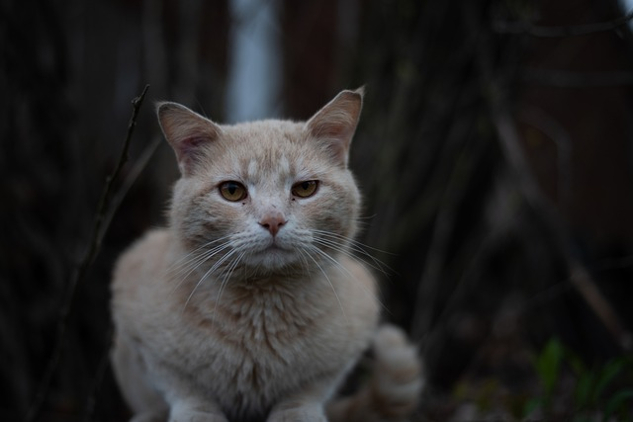
Image by Javon Thorpe
Cats—a mystery. They are like no other animal. Unlike dogs, sheep, goats, cattle, horses, and any other domesticated animal, they aren’t beasts of burden, they don’t produce milk for cheese or yogurt or eggs, they don’t sniff out drugs, and they aren’t food stuff, at least in most cultures under normal circumstances, although there are a couple of exceptions.
So why do we keep them around? Moreover we have (at least in our household) become their servants. We feed them, provide shelter, clean up their cat boxes, brush them and vacuum up the massive amounts of hair they shed, clean up when they spray (which is rare) and vomit (which is more frequent), make sure they are hugged and loved, spend very large sums of money on veterinarian visits, and we do this with a smile on our face and a song in our heart.
The explanation for this—what might be considered irrational behavior—exists deep in time, back with our earliest, earliest ancestors. For as long as primates have been on planet Earth there have been cats and their ancestors. We have evolved together, and this is where we find the origins of not only our servitude to cats, but of their spiritual nature as well.
It is by looking at our ancient past that we can identify our deep connections to cats and our eventual attachment of spiritual characteristics to them. The spiritual nature of cats in many ways reflects ourselves, an echo that emerged over fifty-five million years ago.
The word “spiritual” is thrown about in reference to people, places, and things, and in order to understand what I’m referring to when used with respect to cats, I need to consider the various uses of this and other related terms.
Defining Spirit as an Entity
First, there is spirit as an entity, a god or demon lurking in the dark; spirits can also inhabit people, places, and things, such as with demonic possession, a Tibetan temple, or a tree, as would be the case for Indigenous peoples living in the northeast United States. The Seneca, for example, would find a tree, often basswood, make an offering of tobacco along with ritual prayer, and then carve a face into the tree, thus releasing its spirit. The spirit would then be captured in the form of a medicine mask, used for healing.
Some of these masks are quite similar with the big difference being the shape of the mouth, as it is through the mouth that a particular spirit speaks in order to cure or curse people. Some of these masks are quite old, and the older the mask the more power it contains. The analogy here is that with age comes wisdom (in most cases), and this sentiment becomes attached to the mask. These masks are usually in the care of shamans.
Spirit entities are otherworldly beings thought to interact with humans in both positive and negative ways. We also use the word spirit for an animal or person’s life force that leaves the body during illness, trance, near death experiences, and at death. There may be some validity to this idea of a “life force,” one’s soul, that leaves the body. Shamans are said to be able to control this energy, leave their body, and fly, often with the help of mind-altering substances.
Defining Spirit as an Attitude
Second, “spirit” can also relate to an attitude or psychological state, as to be in “good spirits” or to have “Christmas spirit,” which, in some cases, also alludes to being possessed by good entities.
And then there are the “spirits” one purchases at the liquor store, like “demon rum.” This connection actually comes from Arab alchemists who, when collecting vapors during distillation, considered the vapor as the “spirit” of the material being processed or distilled.
Defining Spiritual as an Aspect of Being
Third, spiritual (a characteristic), as related to a person’s personality or soul, is a nonmaterial aspect of the human animal, and other animals as well. Then there is the religious cleric, a “spiritual leader” who looks after that nonmaterial part of us, like the “life force” mentioned earlier. There is also “spiritual music,” for example, Gospel music sung in church or revival meetings designed to appeal to our otherworldly nature.
Music is very important in many religious traditions as it can act as a medium for contacting that other world through what is called an altered state of consciousness (which is really awareness). One feature of music is the octave (this is a time or space between ascending or descending tones ). Octave theory, the esoteric cosmology taught by G. I. Gurdjieff (1973) as well as Gadalla (2002, 2018), suggests the universe was built on harmonic balance, anticipated in the seven chakras in Hinduism, the Kabala in Judaism, the World Tree or the Christian cross, the axis mundi around which the universe turns—basically that all the secrets of the universe are connected through harmonics.
Defining Spirituality as a Search for Something More
Fourth, spirituality, in some ways is like spirit in that it is conceptualized as something that one searches for in oneself, others, or the universe. Spirituality is considered a good thing, but a “good thing” can be defined in many ways. Martyrdom and murder in the name of a god, for example, might be considered a way to connect with something larger than oneself (Perlmutter 2004; Juergensmeyer 2003; Firestone 1999).
Defining Sacred or Holy as Connected to Otherworldly Matters
Sacred refers to that which is connected to otherworldly matters. The opposite would be secular. However, in my definition, a sacred animal refers to the animal’s characteristics that are interpreted as otherworldly or not possessed by the human animal; it is not that the animal is or was necessarily worshipped. Closely related to sacred is the word “holy.”
Defining Worship
The word “worship” is often used to characterize our relationship to cats, and this needs further clarification. Worship, as anthropologists define the term, involves supplication, begging, and actual servitude to a deity. In Judaism (Yahweh), Christianity (God the Father or Yahweh), and Islam (Allah), one is a slave to the deity, following His instructions to the letter—“or else!” These three deities are not only father figures but, as outlined in a former publication, they are demonic in character (Rush 2023).
Defining Identity with the Divine
Identity with the divine as in polytheistic traditions, rather than servitude, is another issue altogether. With identity you can become the divine—“I and the Father are One.” You can never be God in monotheistic traditions. When most researchers say animal worship, they are really referring to identity with the animal and its perceived otherworldly behaviors or characteristics. Using the above definition, animal worship is quite rare.
Defining Veneration
Veneration is another term used in connection with the spiritual, but it refers to respect or dedication to gods and goddesses, as well as to cats and humans.
Animals as Symbols of Nature, Both Good and Evil
We speak in metaphor. We often refer to nature; for example, to be as “strong as an ox” or that we all have our “mountains to climb.” These statements are not to be taken literally. We use characteristics of nature when describing our world, such as “a rosy colored sunset.” Then there is “the lights are on and no one’s home” or to be “half a bubble off plumb.” These are what we might call urban metaphors, as they are connected to a different technology not available to our ancestors until more recent times.
In order to make such analogies we need experience with colors in nature, animal behavior, and technological sophistication as reference points, especially if we are to share our experiences with others. We describe people as animals, for example, “He’s a rat” (or dog) or “She’s catty,” with each having a reference to some characteristics of animal behavior or, perhaps, insects or plants, that is, to be like a “little gnat” or “dumb as a turnip” (although turnips are pretty smart in their own world). They are ways of describing one’s experience and telling colorful stories; such descriptions help us more clearly share our experiences because, again, they act as general reference points.
Spirit, Spiritual, and Spirituality
The terms spirit, spiritual, and spirituality, however, refer to a different plane of existence, something we are possessed by or with, or that comes from another dimension, or perhaps a special part of us that leaves the body during out-of-body travel, near death experiences, or death. It is also that which lies hidden, although we know it is there.
Many scientists and academics profess that there is nothing beyond what we experience or what can be measured in material science, although many others have doubts, recognizing that there is more to our existence than that which we can measure (Davies 1983, 2008; Grossinger 2022).
Forces of Nature?
Forces of nature, especially for our ancient ancestors, were often considered “otherworldly” or controlled by otherworldly powers, specifically those not understood—for example, why it rains, where lightening comes from, and the power of animals. This lack of understanding turns into what we call magical thinking when describing our experiences and their causes. These narratives are constructed because the mind does not like mysteries, and mysteries can be solved with a story or a myth, for psychological protection, if you will, that aids in our survival.
Worship, again, has to do with ritual process and obedience or following a directive issued by a divine presence and delivered through the deity’s messengers: the priest, rabbi, or imam. On the other side, as mentioned above, is the concept of identity with the divine and actually becoming the divine. For worship, at least in my definition, there is a barrier between you and the divine where you ask for favors, mainly to satisfy your animal nature (life/health, progeny, and economic security of some type that maintains the other two).
In the early Christian cults, the participant could identify with and become (commune with) Jesus. Jesus, at least in my analysis and the conclusions of others, was an experience obtained by consuming the Amanita muscaria mushroom and the ritual processes surrounding its consumption.
After 325 CE this was converted into a religion of worship where Jesus had to become a real person so he could suffer, become a martyr, and die for our sins. After 325 CE you could no longer be God/Jesus, only a follower or adherent with faith (Rush 2022).
Are Cats Divine?
The word divine is often used to describe cats and other animals (Ikram 2014). The word divine can relate, as an adjective, to a deity, a place, or a characteristic a person or other animal might possess. Being forgiving is often considered a divine characteristic. Perceived beauty in nature could be considered divine.
Cats, however, are not divine animals, but they have characteristics that could place them in that category—such as purring or their acute sense of hearing. They may act as an early warning system, as guardians for temple priests or for workers in the field who have to contend with scorpions and snakes.
The question becomes, if cats are divine, are the monster cats divine as well? I suppose that if you consider monsters otherworldly then you have a case for divine, but it is unlikely that most people, except perhaps a satanist, would describe monsters using that terminology.
In review, there is a claim by many that specific animals connected to various cultures were worshipped, but animal worship is rare and it is identity with an animal’s characteristics that these authors are pointing to. In my opinion, there is nothing divine or spiritual in worshipping a god to whom you are enslaved (Yahweh, God the Father, or Allah). Identification with various animals is what brings out our spiritual nature.
Copyright 2023. All Rights Reserved.
Adapted with permission of Destiny Books,
an imprint of Inner Traditions Intl.
Article Source:
BOOK: Cats
Cats: Keepers of the Spirit World
by John A. Rush. Exploring the spiritual nature of cats, John A. Rush looks at humanity’s fascination and fear of cats through the ages. He examines spiritual and occult beliefs connected to cats from Mayan, Aztec, and Native American mythology as well as from ancient India, Samaria, Babylon, Japan, and Egypt, including how ancient Egyptians used cats to send messages to the gods. He also explores similarities between cat and human emotions, cat communications with us, and the deep connection between cats and meditation...
Exploring the spiritual nature of cats, John A. Rush looks at humanity’s fascination and fear of cats through the ages. He examines spiritual and occult beliefs connected to cats from Mayan, Aztec, and Native American mythology as well as from ancient India, Samaria, Babylon, Japan, and Egypt, including how ancient Egyptians used cats to send messages to the gods. He also explores similarities between cat and human emotions, cat communications with us, and the deep connection between cats and meditation...
For more info and/or to order this book, click here. Also available as an Audiobook and a Kindle edition.
 About the Author
About the Author
John A. Rush, Ph.D., N.D.,is a retired professor of anthropology and naturopathic doctor. He is the author of many books, including Spiritual Tattoo, The Twelve Gates, and The Mushroom in Christian Art, as well as the editor of several books, including Entheogens and the Development of Culture.
Visit his website at: ClinicalAnthropology.com/
More books by this Author.

























